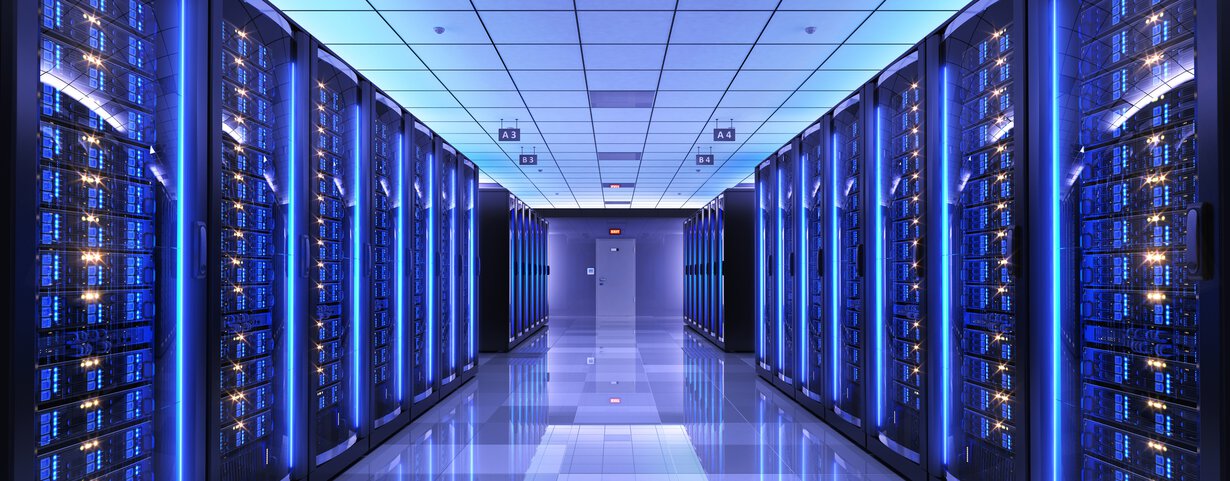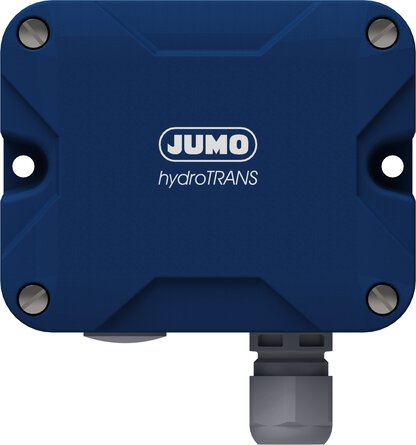

Climate control and cooling in data centers
The uninterrupted operation of data centers and server rooms depends on the continuous monitoring and control of environmental influences. If the appropriate monitoring tools are not available the consequences can be overheating, hardware failures, and a poor PUE value. Fortunately, the JUMO complete system for measuring, controlling, and recording critical measurement parameters ensures maximum security for your data center and can be adapted by our engineering specialists to your specific requirements. You can rely on:
Data center cooling in real life
During operation, machines and plants consume electrical energy, which increases the operating heat of data centers. The resulting waste heat must therefore be efficiently dissipated to constantly keep the air temperature within the optimum temperature range. The hot months in particular require more than just the circulation of warm air. This is where JUMO comes in with its advanced cooling solutions for data centers. A perfectly coordinated system of sensor technology, controls, and evaluations ensures that your data center performs optimally even when temperatures are high.
Sensors
We offer you a comprehensive product range of analog and digital sensors that have been especially developed for the requirements of modern data centers. The covered measurands include temperature, humidity, level, flow, and conductivity.
Control
Our sensors transmit the measured values to the evaluation device/the controller or directly to the automation systems of the JUMO variTRON series using modern communication standards such as IO-Link or Single Pair Ethernet (SPE). This seamless integration enables precise real-time control of the air in the data center.
Evaluation
The evaluation of the JUMO variTRON data is browser-based and carried out via our Cloud/SCADA solution. It can be implemented from any location – even if does not have a data center – as long as it has Internet access. If controlled by a JUMO controller a device from the JUMO variTRON series is required as a gateway.
Multisensor for temperature, humidity, and CO2
S
Intelligent cooling systems for data centers
- Perfect interplay
- Modern communication standards
- Browser-based evaluation
- Customized dashboards
- High level of data security
- Alarm management
Sensor technology and transmitters
Automation
Evaluation
Data center cooling at a glance
The most important background information
Which temperature range is recommended for data centers?
The ideal temperature range is usually between 21 and 24 °C. However, some modern data centers use more flexible temperature guidelines because many devices can operate efficiently at higher temperatures (up to 27 °C or more), which reduces energy costs.
Which cooling methods are particularly effective?
To achieve the best possible cooling performance, various methods can be combined. The choice of these combinations depends on the specific requirements and location of the data center. These methods include
- Free cooling: uses cool outside air to lower the temperature inside, which is particularly energy-efficient in colder climates.
- Liquid cooling: uses fluids such as water or specialized coolants to transfer heat directly from components, which is more efficient than air cooling.
- In-row cooling: places cooling units directly between rows of servers to optimize heat removal and prevent hot spots.
- Cold-aisle/hot-aisle containment: separates cold and warm airflows to increase cooling efficiency and minimize energy loss.
- Adiabatic cooling: uses the evaporation of water to cool the air, which is particularly effective in dry climates.
- Recooling plants: uses cooling towers or dry coolers to release heat into the environment, which is often combined with other methods.
What role does airflow management play for commercial data centers?
Managing airflow is critical to data center cooling. A well-regulated airflow ensures that cool air reaches the servers and warm air is dissipated. This prevents hot spots that can cause overheating and hardware failures. In addition, an optimized airflow results in a reduction of energy consumption, since the cooling systems have to work less to maintain the temperature. Ultimately, a well-thought-out airflow management system increases the reliability and operating life of the IT infrastructure.
What are the advantages of intelligent cooling systems for data centers?
Modern cooling systems automatically adjust the cooling capacity to the current demand in real time, which not only lowers energy consumption but also reduces electricity costs through precise temperature management. Continuous data acquisition enables informed capacity planning and hot spot detection, while remote monitoring capability provides added flexibility and reliability. It allows cooling processes to be controlled remotely and for quick responses to changes, which minimizes downtimes.
What are the current challenges facing data center operators?
The growing popularity of cloud services, machine learning, and the Internet of Things is accelerating the demand for data centers and, with it, the need for effective cooling systems. Adaptability as well as scalability of cooling and climate control, along with the prediction of future heat density, therefore play an important role in the cost-effective operation of data centers. At the same time, the exact measurement of energy consumption is becoming increasingly important due to the growing demand. After all, cooling can account for a significant share of a data center's energy consumption.
How will temperature management in data centers and server rooms develop in the future?
In addition to the integration of intelligent technologies, server development is also becoming increasingly important for cooling in data centers. Modern servers are increasingly being designed to tolerate higher operating temperatures. As a result, the cooling requirements and the environmental impact are also reduced. Similarly, liquid cooling is increasingly being used in data centers, as it enables more efficient heat dissipation than conventional air cooling. The heat is dissipated directly from the components, which is particularly effective in high-density server environments.











